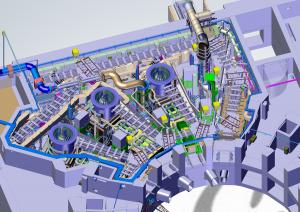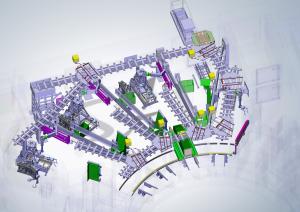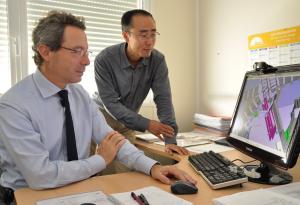Designing components with remote handling in mind
1 Oct 2012
-
Robert Arnoux
The 'innards' of the ITER Tokamak (here the neutral beam cell) are so densely packed that remote handling needs to be an intrinsic feature of a component's design.
With the exception of the European JET and the American TFTR which both, at one point, used the "actual fusion fuels" deuterium and tritium (DT), remote handling was never central to tokamak design.
In ITER, however, it definitely is a key issue. Beginning in 2027, ITER will be the first facility to produce DT plasmas on a regular basis and over an extended period of time. DT plasmas generate very energetic neutrons that will progressively activate (i.e., render radioactive) the components and structures they impact.
The vacuum vessel, blanket modules, divertor system, port plugs and other systems connected to the vacuum vessel (e.g., the neutral beam injection system) will become off-limits to human intervention as DT operation progresses. Areas of the Hot Cell will also become inaccessible for the same reason.
Components exposed to the neutron flux will not last forever; age and degradation will reduce their life expectancy. "A scheduled maintenance program is associated to every one of them," explains ITER Remote Handling Section Leader, Alessandro Tesini. "But we must also prepare for the unexpected and be ready to deploy, at short notice, the necessary tools for any components that could fail."
The ITER machine is extremely complex; its "innards" are so densely packed that remote handling cannot be improvised. "Remote handling needs to be an intrinsic feature of a component's design. It is essential that component designers and remote handling engineers enter a structured dialogue as early as possible in the process and proceed hand-in-hand until the process is complete."
Since the consequences of a non-maintainable tokamak are unacceptable for the project, the efficiency of this relationship needs to be closely monitored, with the remote handling compatibility of each design being assessed on a regular basis.
An important milestone in this process was the Conceptual Design Review (CDR) for the neutral beam remote handling system in July this year. The CDRs for the blanket remote handling system and the divertor remote handling system were held in February 2011 and June 2011 respectively.
To prepare for this CDR, the ITER Remote Handling Section worked closely with the ITER Neutral Beam Section. They were also supported by F4E and the Culham Centre For Fusion Energy (CCFE), which has accumulated a great deal of experience in tokamak remote handling at JET.
While ITER managed the configuration and integration of the Neutral Beam remote handling system in the Tokamak Building, F4E managed the design progress and deliverables, with CCFE providing the system design and analysis results. This joint effort was behind the successful completion of the CDR.
ITER Remote Handling Section Leader, Alessandro Tesini, and Technical Responsible Officer (neutral beam remote handling) Chang Hwan: " It is essential that component designers and remote handling engineers enter a structured dialogue as early as possible in the process of a component's design."
The CDR Review Panel was particularly impressed by the virtual reality animations—realistic 3D sequences used to assess the equipment trajectories in the complex neutral beam cell environment. "Like in a flight simulator, these animations provide a lot of information with minimum effort, highlighting, for example, where and when a clash between equipment and structures could occur."
In addition, physical mockups may be used to simulate situations where component deflection and/or relative friction play a role that cannot be modelled in virtual reality.
"The CDR for the neutral beam remote handling system concluded that the system's conceptual design satisfactorily answers the requirements while respecting the interfaces," says Tesini. "We are now engaged in the CDR follow-up work to address the issues raised by experts during the review. We will then write the final specification which will form the core of the Procurement Agreement to be signed between the ITER Organization and the European Domestic Agency."
Manufacturing of the neutral beam remote handling system is expected to start around 2016-2017 so it can be installed in early 2019. Years before it is required for remote maintenance, the system will be put to work to assemble the neutral beam components inside the neutral beam cell. "From a topological point of view," says Tesini, "there is no other solution."




